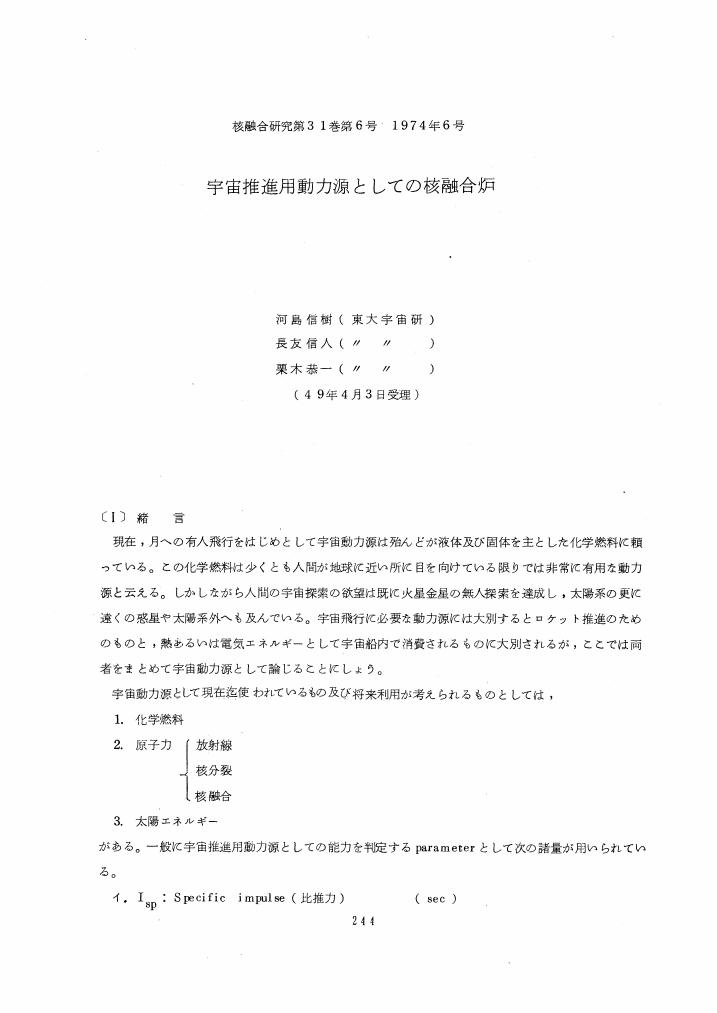1 0 0 0 OA 電離層におけるロケット排出物の拡散と電子減少
- 著者
- 石川 芳男 井上 正史 小宅 康博 山極 芳樹 栗木 恭一
- 出版者
- 一般社団法人 日本航空宇宙学会
- 雑誌
- 日本航空宇宙学会誌 (ISSN:00214663)
- 巻号頁・発行日
- vol.41, no.471, pp.205-212, 1993-04-05 (Released:2010-12-16)
- 参考文献数
- 9
- 被引用文献数
- 1 1
In coming new space age, we will have frequent trips between the ground and mission orbits by large rockets to realize the large projects such as space stations and solar power satellite systems. In such cases a great deal of rocket effluents should be released in the atomosphere. But, its effects on our environment is still unknown, and therefore various studies on these problems are expected. About such environmental problems, some studies were performed which motivated by so called “ionospheric hole” observed when Skylab-I was launched, May 14, 1973. It was certified by later scientific studies that the phenomenon was caused by the chemical reaction between rocket effluents and ionized particles in the ionosphere, by which the electron density of the ionosphere suddenly decreased to about a half values of that in its normal state in the range of about 1, 000km in radius centering about rocket trajectory and it took about 4 hours to recover. In this study, the results of these fundamental studies are applied to the engineering problem, that is, the numerical simulation of the change in electron density in the ionosphere is carried out in consideration of the diffusion of rocket effluents released along arbitrary trajectory in upper atomosphere and their chemical reactions with the ionospheric constituents.
1 0 0 0 OA Space Flyer Unit (SFU) ミッション概要
- 著者
- 栗木 恭一 佐々木 進 横田 力男
- 出版者
- 日本マイクログラビティ応用学会
- 雑誌
- 日本マイクログラビティ応用学会誌 (ISSN:09153616)
- 巻号頁・発行日
- vol.14, no.3, pp.211, 1997-07-31 (Released:2021-01-21)
- 参考文献数
- 7
- 被引用文献数
- 2
The Space Flyer Unit (SFU) is an unmanned free flyer flown in orbit from March 18, 1995 to January 20, 1996. Space environments such as microgravity and surrounding atmospheric conditions were monitored and are reviewed as reference for future missions. Engineering impacts of microgravity on spacecraft are also reviewed including post flight analyses.
1 0 0 0 OA ヒドラジン分解反応促進に対する放電プラズマの適用検討
- 著者
- 青柳 潤一郎 各務 聡 竹ヶ原 春貴 橘 武史 三島 弘行 齋藤 憲吉 長島 隆一 栗木 恭一
- 出版者
- 一般社団法人 日本航空宇宙学会
- 雑誌
- 宇宙技術 (ISSN:13473832)
- 巻号頁・発行日
- vol.4, pp.1-6, 2005 (Released:2005-03-01)
- 参考文献数
- 11
Conventional monopropellant thrusters for spacecraft utilize the pelletized catalyst bed to decompose the propellant, typically Hydrazine. The catalyst bed consists of Iridium catalyst supported by porous Alumina ceramics pellets. During the long-term operation of the thruster, however, the catalyst is occasionally damaged, which causes several critical problems like a deterioration of the decomposition performance or choke of the capillary tube. In order to solve or mitigate these problems, a new decomposition device was designed and its preliminary model was fabricated and evaluated in our research group. Preliminary tests were conducted to examine the new reaction mechanism using pulsed or stationary AC discharge plasma instead of pelletized catalysts in a bucket type reaction chamber. In the reaction chamber filled with Hydrazine, sudden increase of the temperature and the pressure was observed immediately after the production of plasma discharge. These results show that the plasma is capable of the decomposition of Hydrazine, and acts as catalysts, and that it is worthwhile developing a new monopropellant thruster system using plasma assisted reaction in order to eliminate the disadvantages associated with the pelletized catalyst bed.
- 著者
- 栗木 恭一 黒河 治久
- 出版者
- 公益社団法人精密工学会
- 雑誌
- 精密工学会誌 (ISSN:09120289)
- 巻号頁・発行日
- vol.61, no.12, pp.1641-1644, 1995-12-05
1 0 0 0 OA 宇宙推進用動力源としての核融合炉
- 著者
- 河島 信樹 長友 信人 栗木 恭一
- 出版者
- 社団法人 プラズマ・核融合学会
- 雑誌
- 核融合研究 (ISSN:04512375)
- 巻号頁・発行日
- vol.31, no.6, pp.244-253, 1974 (Released:2011-03-04)
- 参考文献数
- 4

